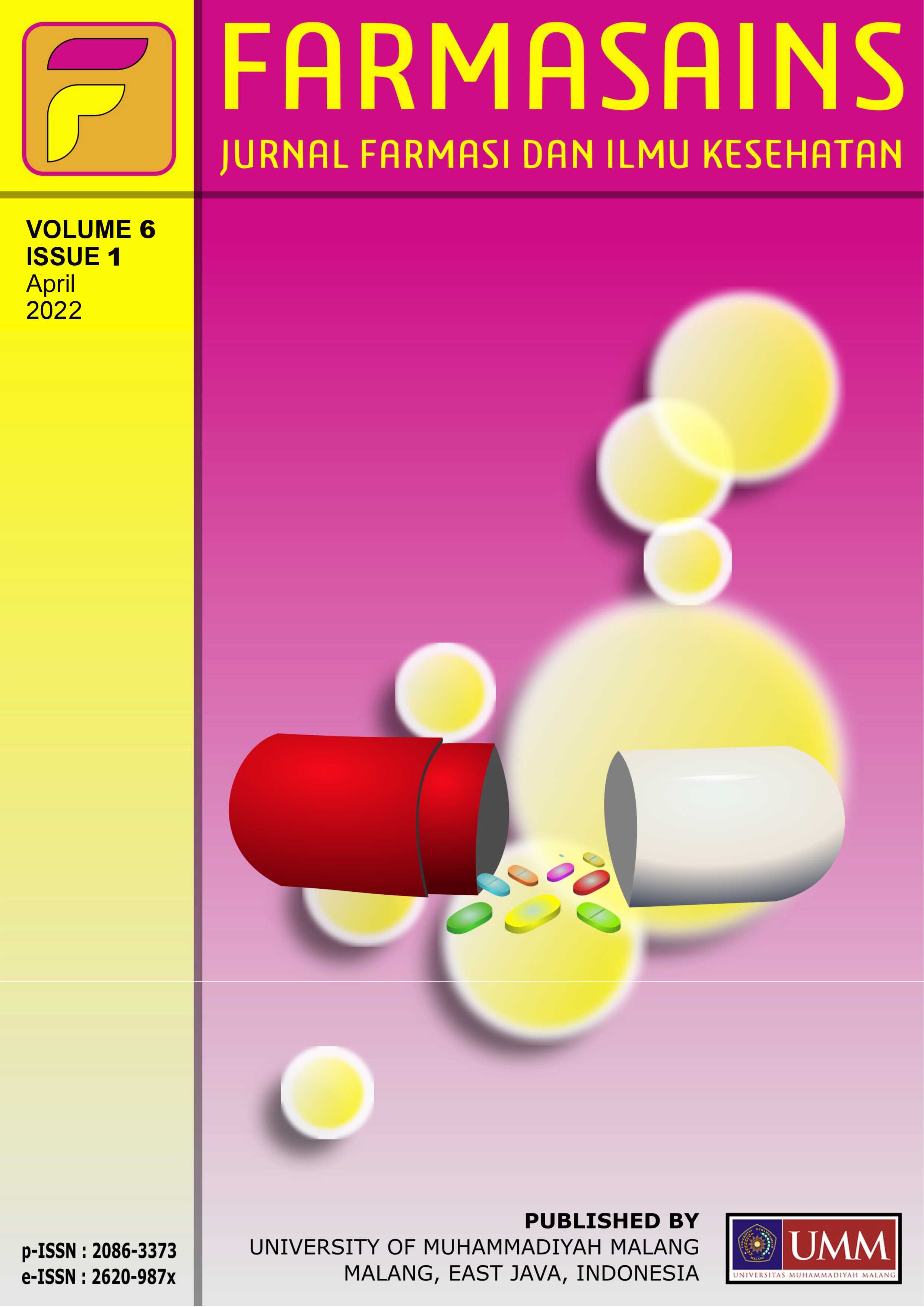Analysis of antioxidant activity of carrots (Daucus carrota L.) using FRAP and CUPRAC methods
DOI:
https://doi.org/10.22219/farmasains.v6i1.13981Keywords:
Antioxidants, Carrots (Daucus carrota L.), FRAP, CUPRACAbstract
Carrot antioxidant activity analysis has been carried out. Carrot juice was analyzed qualitatively by the FRAP method using FRAP reagent and by the CUPRAC method using copper (II) chloride solution, neucuproine solution, ammonium acetate buffer solution, and distilled water. Quantitatively, the mixture of sample solutions using the FRAP and CUPRAC methods was analyzed using a UV-Vis spectrophotometer at a wavelength of 596 nm for the FRAP method and 452 nm for the CUPRAC method, using Trolox solution as the standard curve. The results obtained were that each sample A and B's antioxidant activity using the FRAP method was 0.5186 µM TR/g and 0.8857 µM TR/g samples. Meanwhile, samples A and B's antioxidant activity using the CUPRAC method was 0.1160 µM TR/g sample and 0.1762 µM TR/g sample.
Downloads
References
Apak, R., Güçlü, K., Demirata, B., Özyürek, M., Çelik, S. E., Bektaşoğlu, B., ... & Özyurt, D. (2007). Comparative evaluation of various total antioxidant capacity assays applied to phenolic compounds with the CUPRAC assay. Molecules, 12(7), 1496-1547.
Belitz, H. D., Grosch, W., Schieberle, P. (2009). Food Chemistry, 4th ed. Berlin, Germany: Springer-Verlag Berlin
Heidelberg.
Benzie, I. F., & Strain, J. J. (1996). The ferric reducing ability of plasma (FRAP) as a measure of “antioxidant power”: the FRAP assay. Analytical biochemistry, 239(1), 70-76.
Cahyono, B. (2002). Wortel: Teknik Budi Daya dan Analisis Usaha Tani. Yogyakarta, Indonesia: Kanisius.
Gandjar, I. G., & Rohman, A. (2007). Farmasi Kimia Analisis. Yogyakrta, Indonesia: Pustaka Pelajar.
Halliwell, B., & Gutteridge, J. M. C. (2015). Free Radicals in Biology and Medicine, 5th ed. Oxford, United Kingdom: Oxford University Press.
Huang, D., Ou, B., & Prior, R. L. (2005). The chemistry behind antioxidant capacity assays. Journal of agricultural
and food chemistry, 53(6), 1841-1856.
Ketaren, S. (2008). Pengantar teknologi minyak dan lemak pangan. Jakarta, Indonesia: UI Press.
Momuat, L. I., Sangi, M. S., & Purwati, N. P. (2011). Pengaruh VCO mengandung ekstrak wortel terhadap
peroksidasi lipid plasma. Jurnal Ilmiah Sains, 11(2), 296-301.
Ou, B., Huang, D., Hampsch-Woodill, M., Flanagan, J. A., & Deemer, E. K. (2002). Analysis of antioxidant activities of common vegetables employing oxygen radical absorbance capacity (ORAC) and ferric reducing antioxidant power (FRAP) assays: a comparative study. Journal of agricultural and food chemistry, 50(11), 3122-3128.
Özyürek, M., Güçlü, K., Tütem, E., Başkan, K. S., Erçağ, E., Çelik, S. E., ... & Apak, R. (2011). A comprehensive review of CUPRAC methodology. Analytical methods, 3(11), 2439-2453.
Szőllősi, R., & Varga, I. S. I. (2002). Total antioxidant power in some species of Labiatae: Adaptation of FRAP method. Acta Biologica Szegediensis, 46(3-4), 125-127.
Widyastuti, N. (2010). Pengukuran aktivitas antioksidan dengan metode Cuprac, DPPH, dan Frap serta
korelasinya dengan fenol dan flavanoid pada enam tanaman. (Undergraduate’s Thesis). Institut Pertanian
Bogor, Bogor, Indonesia.
Winarsi, H. (2007). Antioksidan Alami & Radikal Bebas: Potensi dan Aplikasinya dalam Kesehatan. Yogyakarta, Indonesia: Kanisius.
Downloads
Published
How to Cite
Issue
Section
License
Copyright (c) 2021 Aprilya Sri Rachmayanti, Nurmaya Effendi, Andi Muflihunna

This work is licensed under a Creative Commons Attribution 4.0 International License.
Authors who publish with this journal agree to the following terms:
a. Authors retain copyright and grant the journal right of first publication with the work simultaneously licensed under a Creative Commons Attribution License that allows others to share the work with an acknowledgement of the work's authorship and initial publication in this journal.
b. Authors are able to enter into separate, additional contractual arrangements for the non-exclusive distribution of the journal's published version of the work (e.g., post it to an institutional repository or publish it in a book), with an acknowledgement of its initial publication in this journal.
c. Authors are permitted and encouraged to post their work online (e.g., in institutional repositories or on their website) prior to and during the submission process, as it can lead to productive exchanges, as well as earlier and greater citation of published work (See The Effect of Open Access).













